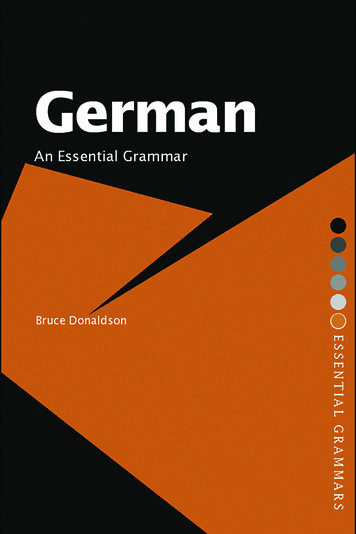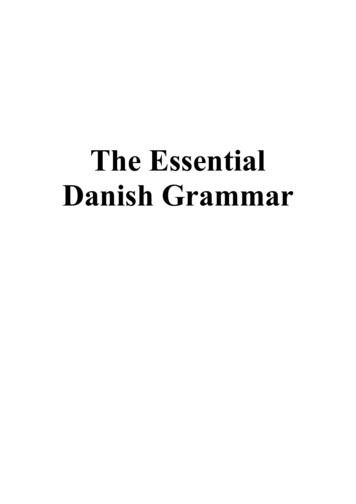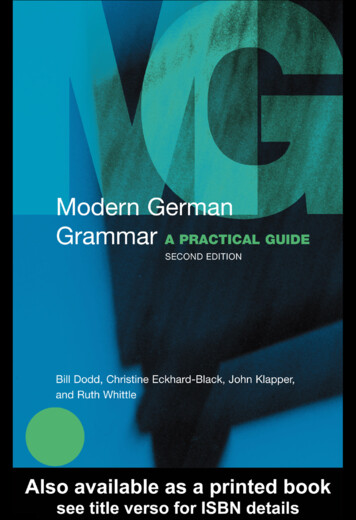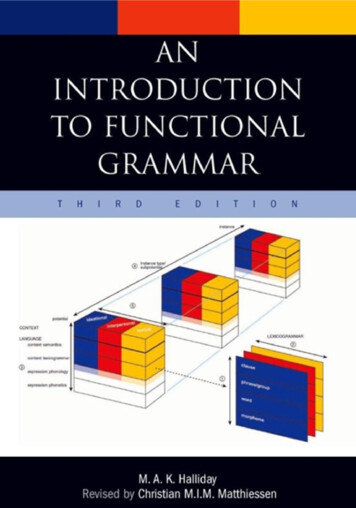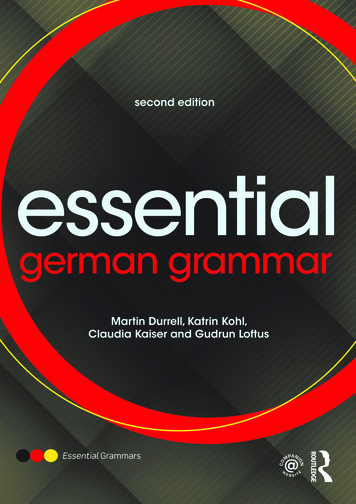
Transcription
Essential German GrammarEssential German Grammar is a student-friendly grammar and workbook designed togive learners a firm foundation on which to build a real understanding of both spoken andwritten German. The reference grammar section offers clear explanations of key grammarpoints while a separate exercise section gives students the opportunity to test themselvesand put into practice what they have learnt.This new edition has been revised and updated throughout. Explanations, tables andexercises have been improved and a number of the authentic texts and illustrations havebeen replaced by new material. Key features of this second edition include:១User-friendly layout with updated two-colour design, engaging illustrations and visuallyappealing tables throughout to aid the learning process១Clear and accessible explanations with memorable examples informed by the latestresearch on the German language and presented in accordance with current teachingmethodology១Helpful parallels between English and German provided where relevant១End-of-chapter extracts taken from contemporary journalistic or authentic literarysources, illustrating grammar in context, with model translations provided at the back ofthe book១Material to enable better strategic learning and understanding, including a WhyGrammar? – FAQ section, a glossary of grammatical terms in both English and Germanand a complete answer key to exercises១Created especially for the new edition, a companion website at www.routledge.com/cw/kaiser offering a wealth of additional materials, including interactive exercises, quizzesand flashcards to test student understanding, downloadable PDF sheets for classroomuse, PowerPoint slides for instructors and audio recordings illustrating the sounds ofspoken German.Written by highly experienced lecturers in the field, Essential German Grammar is aninvaluable resource for intermediate and advanced students of German (CEFR levels A2 toB2, ACTFL Novice High to Intermediate High). It is designed to function equally as afree-standing grammar or as a foundation grammar for Hammer’s German Grammar andUsage and is suitable for both classroom use and self-study.Martin Durrell is Emeritus Professor of German at the University of Manchester, UK.Katrin Kohl is Professor of German Literature at Jesus College, University of Oxford, UK.Claudia Kaiser is Senior German Language Instructor, University of Oxford, UK.Gudrun Loftus was Senior German Language Instructor, University of Oxford, UK.
“Essential German Grammar is exceptionally straightforward to use, full ofuseful exercises and examples, and written with an eye for salient detail. Iwould recommend it confidently to students at A level and beyond. It is not justa valuable source of information; the book also explains cogently why you can’tjust ‘do without’ grammatical knowledge. It will help learners appreciate that,far from an inconvenience, the striving for a mastery of grammar is absolutelycentral to successful advanced language learning.”Geoffrey Plow, University College School, UK“Here now is finally a German grammar that stands out from the crowd:modern, pleasing on the eye and bursting with self-correcting exercises, backedup by a complementary website to make it a book of its era. The ideal grammarto work through prior to taking on the ultimate reference work on the topic,Martin Durrell’s Hammer’s German Grammar and Usage.”Bruce Donaldson, formerly at The University of Melbourne, Australia“Clearly set out, this useful reference work is student-friendly. The two colourdesign makes examples clear and easy to access; contemporary text extracts,amusing illustrations together with exercises (and answers) as well asexplanations in English take the frustration out of learning German grammar.Essential German Grammar is a highly recommended addition to any postbeginner’s German course.”Kathleen Thorpe, University of the Witwatersrand, Johannesburg“Students of German with English language backgrounds will welcome thesecond edition of the Essential German Grammar. It is an excellent, userfriendly stand-alone Grammar which presents the basic structures of German ina clear and systematic manner. Grammatical concepts are explained in aglossary which teachers too will find useful. The emphasis on learning ruleswith examples of authentic usage will be very helpful for learners who wish tomove to an advanced level of competence in German. This well designedvolume is highly recommended.”Anil Bhatti, Jawaharlal Nehru University, India“An invaluable tool for every serious student of German. Concise and clearlywritten – yet covering all the key elements of German grammar – it is withoutquestion one of the most user-friendly grammars currently available.”Seán Allan, University of Warwick, UK
Essential Language GrammarsEssential Language Grammars are available for the following languages:FrenchGerman
This page intentionally left blank
ESSENTIALGERMANGRAMMARMARTIN DURRELLEmeritus Professor of German, University of ManchesterKATRIN KOHLProfessor of German, Jesus College, University of OxfordCLAUDIA KAISERSenior German Language Instructor, University of OxfordGUDRUN LOFTUSFormerly Senior German Language Instructor, University of Oxford
Second edition published 2015by Routledge2 Park Square, Milton Park, Abingdon, Oxon OX14 4RNand by Routledge711 Third Avenue, New York, NY 10017Routledge is an imprint of the Taylor & Francis Group, an informa business 2002 Martin Durrell, Katrin Kohl, Oliver Loftus 2015 Martin Durrell, Katrin Kohl, Claudia Kaiser, Oliver LoftusThe right of Martin Durrell, Katrin Kohl, Claudia Kaiser and Gudrun Loftus to be identified as authors of this workhas been asserted by them in accordance with sections 77 and 78 of the Copyright, Designs and Patents Act 1988.All rights reserved. No part of this book may be reprinted or reproduced or utilised in any form or by anyelectronic, mechanical, or other means, now known or hereafter invented, including photocopying andrecording, or in any information storage or retrieval system, without permission in writing from the publishers.Trademark notice: product or corporate names may be trademarks or registered trademarks, and are used onlyfor identification and explanation without intent to infringe.First edition published in Great Britain in 2002 by Hodder Education and republished in 2013 by Routledge.British Library Cataloguing in Publication DataA catalogue record for this book is available from the British LibraryLibrary of Congress Cataloging in Publication DataDurrell, Martin, author.Essential German Grammar / Martin Durrell, Emeritus Professor of German, University of Manchester ; KatrinKohl, Professor of German, Jesus College, University of Oxford ; Claudia Kaiser, Senior German LanguageInstructor, University of Oxford ; Gudrun Loftus, Formerly Senior German Language Instructor, University ofOxford. -- Second Edition.p. cm. -- (Essential language grammars)1. German language--Grammar. 2. German language--Usage. I. Kohl, Katrin M. (Katrin Maria), 1956- author. II.Kaiser, Claudia (Language specialist) author. III. Loftus, Gudrun, author. IV. Title.PF3112.D76 2015438.2’421--dc232014032877ISBN: 978-1-138-78581-6 (pbk)ISBN: 978-1-315-72807-0 (ebk)Typeset in ITC Garamond and Gill Sansby Saxon Graphics Ltd, Derby
CONTENTSPrefaceAcknowledgementsWhy grammar?Abbreviations and spellingGlossary12WORDS AND SENTENCESxiiixvxviixxixxiii11.1 Words and how they are linked in a sentence1.2 The subject and the finite verb1.3 Direct objects1.4 Dative objects1.5 Prepositional objects1.6 sein ‘be’ and its complements1.7 Sentences and clauses1.8 Main clauses1.9 Questions and commands1.10 Subordinate clausesWords and sentences in context1567891012141518NOUNS202.1 Gender2.2 Masculine nouns2.3 Feminine nouns2.4 Neuter nouns2.5 Other clues to gender2.6 Noun plurals2.7 The plural of masculine nouns2.8 The plural of feminine nouns2.9 The plural of neuter nouns2.10 Plurals in -s (and other foreign plurals)2.11 Case2.12 Case marking on the nounNouns in context20212223232425272829293134
CONTENTS345viiiTHE NOUN PHRASE: DETERMINERS ANDPRONOUNS363.1 The definite article3.2 The indefinite article3.3 Uses of the articles3.4 Demonstratives3.5 Possessives3.6 Other determiners3.7 Personal pronouns3.8 Reflexive pronouns3.9 Demonstrative, possessive and indefinite pronounsThe noun phrase in context37373840424345484852ADJECTIVES, ADVERBS AND ADVERBIALS544.1 Adjective declension4.2 Adjective declension: some special cases4.3 Adjectives used as nouns4.4 Adjectives with the dative4.5 Adjectives with prepositions4.6 Comparison of adjectives4.7 Some uses of the comparative and superlative4.8 Adverbs and adverbials4.9 Time adverbials4.10 Adverbs of place4.11 Adverbs of direction4.12 Adverbs of attitude4.13 Adverbs of manner4.14 Adverbs of degree4.15 Interrogative adverbials4.16 Adverb comparison4.17 Cardinal numbers4.18 Ordinal numbers4.19 Fractions4.20 Clock times, days of the week and months4.21 Modal particlesAdjectives, adverbs and adverbials in 6PREPOSITIONS785.1 Prepositions with the accusative5.2 Prepositions with the dative5.3 Prepositions with the dative or the accusative5.4 Prepositions with the genitive5.5 Prepositional adverbsPrepositions in context808286919294
CONTENTS678VERBS: FORMS966.1 Principal parts: weak, strong and irregular verbs6.2 Tenses: general6.3 Conjugation of weak and strong verbs in simple tenses6.4 Separable and inseparable verbs6.5 Conjugation of irregular verbs6.6 Compound tenses6.7 haben or sein in the perfect?6.8 Forms of the passive6.9 Forms of the subjunctive6.10 Vowel changes with strong verbs6.11 List of strong and irregular verbsVerb forms in context969899102103104106107108110112118VERBS: USES1217.1 The tenses and their use7.2 Present and future7.3 Past and perfect7.4 The passive with werden7.5 The ‘subjectless’ passive7.6 The passive with dative objects7.7 von or durch with the passive7.8 The passive with sein7.9 Alternatives to passive constructions7.10 The subjunctive: general7.11 Subjunctive II: conditional sentences7.12 Subjunctive I: reported speech7.13 The modal auxiliary verbs7.14 dürfen7.15 können7.16 mögen7.17 müssen7.18 sollen7.19 wollenVerb uses in 35136137137138140VALENCY AND CASES1428.1 Sentence patterns8.2 Reflexive verbs8.3 Dative objects8.4 Other uses of the dative case8.5 The genitive case8.6 Prepositional objects8.7 Predicate complements8.8 Direction and place complementsValency and cases in context143146149151152154160161164ix
CONTENTS9WORD ORDER1689.1 The ‘bracket’ construction9.2 Verbs at the end of the clause9.3 First position in main clauses9.4 The order of words and phrases in the central section9.5 The position of pronouns9.6 The position of the noun subject and objects9.7 The position of adverbials9.8 The position of complements9.9 The position of nicht9.10 Placing elements after the verbal bracketWord order in context16917117217417417517517717717818010 COMPLEX SENTENCES10.1 Coordination and subordination10.2 Coordination10.3 Subordination: noun clauses10.4 Subordination: other conjunctions10.5 Subordination: relative clauses10.6 Infinitive clauses10.7 Infinitive clauses after prepositions10.8 The infinitive without zuComplex sentences in context11 WORD FORMATION11.1 The basics of word formation11.2 The formation of nouns11.3 Compound nouns11.4 The formation of adjectives11.5 Inseparable verb prefixes11.6 Separable verb prefixes11.7 Variable verb prefixes11.8 Other ways of forming verbsWord formation in 208211214215217219
CONTENTS12 SPOKEN AND WRITTEN GERMAN22212.1 The relationship between pronunciation and spelling12.2 German spelling12.3 The use of capital letters12.4 One word or two?12.5 -ss- and -ß12.6 Punctuation: the comma12.7 Other punctuation marks12.8 Register12.9 Colloquial and formal pronunciation12.10 Register differences in grammar12.11 Register differences in vocabularyRegister in ES241Chapter 1: Words and sentencesChapter 2: NounsChapter 3: The noun phrase: determiners and pronounsChapter 4: Adjectives, adverbs and adverbialsChapter 5: PrepositionsChapter 6: Verbs: formsChapter 7: Verbs: usesChapter 8: Valency and casesChapter 9: Word orderChapter 10: Complex sentencesChapter 11: Word formationChapter 12: Spoken and written GermanAnswers to exercisesGrammar in context: 312317341350xi
This page intentionally left blank
PREFACEThis book is designed to introduce the basic grammatical structures of German and give awide range of examples to illustrate how they are used in practice. As the title EssentialGerman Grammar indicates, it is not a comprehensive reference work, and the focus ison presenting the most important aspects of German grammar clearly and approachably.Much of the material is given in tables, which use two colours in order to make it easier tofocus on key points and memorize rules. Explanations are intended both to clarifyindividual points and to develop an appreciation of how German grammar operates as asystem. Each chapter finishes with an authentic text that illustrates how the grammarpoints work in context. A separate section with exercises and answers enables learners totest themselves on what they have learnt.In principle, the individual chapters are self-contained and are not intended to be workedthrough in the order in which they are presented in the book. The exception to this ischapter 1, which provides a basic introduction to how German sentences are made up. It islonger than the other chapters and learners are advised to study it carefully first, beforegoing on to later chapters which generally provide more detail about the aspects ofgrammar introduced in chapter 1.The book is intended to be suitable for use as a stand-alone grammar for post-beginners atschool or university, i.e. those who have already acquired a basic knowledge of German(e.g. through completing a GCSE in England or a one-year university beginners course)and want to build on this systematically. This means that it is designed primarily forlearners whose command of the language has reached A2 of the Common EuropeanFramework of Reference for Languages (CEFR) or ‘novice high’ by the guidelines of theAmerican Council on the Teaching of Foreign Languages (ACTFL) and who are looking toprogress to CEFR level B2 or ACTFL ‘intermediate high’, or beyond.At the same time, it is designed as a foundation grammar for Hammer’s GermanGrammar and Usage, by Martin Durrell (5th edition Routledge, 2011). Hammer gives theadvanced learner a deeper understanding of German grammar, and it explains complexareas of the language not covered in this more elementary book. Nevertheless, the learnerwill still find it useful to keep referring back to the tables and summaries in EssentialGerman Grammar.
PREFACEThe companion website offers a wide range of additional exercises on all the main areas ofGerman grammar. The exercises are mainly designed for self-study, but can also be used toaccompany instructed grammar courses. As in the book, the exercises are organized bychapter and sub-chapter. Within a sub-chapter, the exercises are normally graded, with thelater ones being more challenging. Students are given the opportunity to familiarizethemselves with grammatical terminology via flashcards; the audio section gives learnersthe opportunity to listen to the authentic texts that accompany each chapter in EssentialGerman Grammar; and PowerPoint presentations suitable for classroom use are providedfor instructors. These presentations cover the main areas of grammar and includeexamples. They may be adapted by teachers to suit their students’ needs or learners mayalso wish to use them independently. Additionally, instructors will find exercises fordownload covering the main chapters in PDF format.The authors would like to thank colleagues and students at the University of Manchesterand the University of Oxford, whose questions have helped to shape this book – inparticular Wiebke Brockhaus-Grand and Thomas Despositos – as well as a number ofanonymous reviewers in the UK and the USA who provided invaluable feedback. Dr SoniaBrough and Erica Parsons provided many constructive criticisms and helpful suggestions.The authors must also acknowledge their immense debt to Gudrun Loftus, who was aco-author of the first edition and who sadly died in tragic circumstances in autumn 2010.Finally, our thanks go to Lesley Riddle, Elena Seymenliyska, Eva Martinez and AnkeUeberberg at Arnold, who were responsible for seeing the first edition through tocompletion, and to Andrea Hartill, Isabelle Cheng and Sarah Douglas at Routledge for theenthusiasm and expertise with which they supported the production of this revisededition.xiv
ACKNOWLEDGEMENTSThe authors and publisher would like to thank the following for permission to usecopyright material in this book.TextsTexts are abbreviated and/or adapted.Chapter 1: Erich Kästner/Walter Trier: Münchhausen Atrium Verlag, Zürich (1938), p.88. Chapter 2: Circus Krone, Programme December 2000/January 2001, p. 39. Chapter 3:‘Verrückte Tierfreundschaften’, Popcorn, No. 8, 2014, pp. 12–13. Chapter 4: ‘SuchtfalleInternet’, Cosmopolitan, No. 5, May 1999, p. 160. Chapter 5: ‘Meine üble Knastvergangenheit’, Bravo, No. 29, 9.7.2014, p. 22. Chapter 6: ‘Mein Leben in China hat michzum Brot-Freak gemacht’, Capital, No. 7, Juli 2014, pp. 72–73. Chapter 7: Jacob andWilhelm Grimm, ‘Hänsel und Gretel’, in: Brüder Grimm, Kinder- und Hausmärchen.Ausgabe letzter Hand mit den Originalanmerkungen der Brüder Grimm, ed. H. Rölleke,3 vols (Stuttgart: Reclam 1984), vol. 1, pp. 106f. Chapter 8: ‘Neue Niere, neues Leben’,Stern, No. 50, 5.12.2013. Chapter 9: Prof. Dr. Christian Spaeth, ‘Säugetiere der Vorzeit’,WAS IST WAS Band 38, 2010, 2006 Tessloff Verlag, Nürnberg, Germany. Chapter 10:Franz Kafka, Der Heizer, in: Sämtliche Erzählungen, ed. Paul Raabe (Frankfurt/M.,Hamburg: Fischer 1970), p. 32. Chapter 11: Margit Schlesinger-Stoll: ‘Psychotherapie amMonitor’, Psychologie Heute, January 2014 [Thema: Zufriedenheit], pp. 44–47 Psychologie Heute, Germany. Chapter 12: ‘Bist du ein Fitness-Typ?’ Popcorn, No. 5, Mai1999, p. 86; Kurt-Martin Mayer/Simone Kunz: ‘Laufen streichelt die Seele’, Focus, pp.103–106. Exercises: Fernsehwoche: No. 34, 26.8.–1.9.2000, p. 5 (Chapter 1); No. 27,8.–14.7.2000, p. 5 (Chapter 4); No. 21, 27.5.–2.6.2000, p. 12 (Chapter 5); No. 23, 10.–16.6.2000, p. 6 (Chapter 6); No. 36, 9.–15.9.2000, pp. 10f. (Chapter 7); No. 23, 10.–16.6.2000, p. 7 (Chapter 7). TV-Zeitschrift Fernsehwoche.IllustrationsChapter 1: Erich Kästner/Walter Trier: Münchhausen Atrium Verlag, Zürich (1938).Chapter 2: Circus Krone, Programme December 1999/January 2000, title page and pp.
ACKNOWLEDGEMENTS20f. Chapter 3: Illustrations of animals Routledge, Taylor and Francis. Chapter 4:Photograph: Andrey Popov/Shutterstock.com. Chapter 5: DFree/Shutterstock.com.Chapter 6: Photo: Tim UR/Shutterstock.com. Chapter 7: Acht der schönsten GrimmsMärchen, illustrated by anon, p. 13. Chapter 8: Ivan Galashchuk/Shutterstock.com;Angelika Kauffman’s 1787 painting of Goethe, then 38 years old: Klassik Stiftung Weimar/Fotothek. Chapter 9: Rainer Albiez/Shutterstock.com. Chapter 10: Cartoon, BravoSport, Nos. 8, 9, April 1999, p. 32; ‘Statue of Liberty’, photograph Matej Hudovernik/Shutterstock.com. Chapter 11: Artwork: Karsten Petrat. Chapter 12: Popcorn No. 5, May1999, p. 86; EpicStockMedia/Shutterstock.com. Chapters 1–9 and 11–12: Cartoons byErik Liebermann, in: Unverhofft kommt oft, ed. Gesamtverband der DeutschenVersicherungswirtschaft e.V. (GDV), Cologne 1986.Every effort has been made to trace copyright holders of material reproduced in this book;any rights not acknowledged here will be acknowledged in subsequent printings if noticeis given to the publisher.xvi
WHY GRAMMAR?Some frequently asked questionsCan language learning be made easy?The simple answer is no – whatever certain methods promise you. You can quickly learn afew useful phrases, but you can’t learn to communicate properly without a lot of effort. Aswith a musical instrument, you also need to practise regularly what you learn in order notto forget it. But you can enhance your efficiency:១Develop an awareness of what types of learning work best for you.១Vary the ways you learn.១Use your teacher and any (other) native speakers to help you.Are there any shortcuts to learning a language?Yes – learning its grammar! For each rule you learn to use, you can produce a hugenumber of different sentences.Does German have ‘more grammar’ than English, French or Spanish?No. The grammar of a language is its basic framework which allows you to combine a finitenumber of words in an infinite number of ways – and still be understood immediately. Butin different languages, different parts of the framework are developed in more or lesscomplex ways. This means that difficulties can lie in different aspects of the language andconfront the learner at different stages. German seems to have ‘more grammar’ at thebeginning because it’s an ‘inflecting’ language: the structure of certain words changes(typically, different endings are used) depending on their function in the sentence. Butother areas of German grammar are comparatively simple (there are not that manyirregular verbs, for instance), and developing your vocabulary in German is helped by thebig ‘word families’ you can build up with the rules of word formation.Isn’t it best to concentrate on communicating and forget about those silly littleendings?Even without the details, it’s possible to reach a stage where you can order the right drink ina restaurant, you can manage to tell people where you went on holiday, and get the gist ofsimple conversations or films. But you’ll never get your command of German to a pointwhere you can take part in more complex (and interesting) conversations – or businessnegotiations – or understand sophisticated texts or documentaries. Even popular
WHY GRAMMAR?newspapers can be quite challenging. You’re also not taken as seriously if you make mistakes– just think of how people (even you!) react to foreigners who speak ungrammatical orinaccurate English. If you’re aiming for a good command of German in the long term, youneed to get into the habit of caring about the detail from the start. But it’s still a good idea tovary your aims: set aside times for switching into ‘basic communication’ mode.Is it best to learn grammar in context, by listening to German and reading it?It’s very important to see how grammar works in the context of real conversations andtexts. But it’s essential to get hold of the rules systematically if you want to make fastprogress. After all, you wouldn’t expect to learn to play football or tennis just by watchingmatches on television.Is it best to avoid translating when learning grammar?You can’t assume that an English phrase or construction can be transposed directly intoGerman, though in fact the two languages are in many ways similar. But it’s very useful tolearn grammar by comparing where they do things in similar ways and where they aredifferent. After all, you’ve spent thousands of hours mastering the grammar of your nativelanguage (even if much of it is subconscious), and you really can make use of thatknowledge when learning German. Some people think translation is an ‘unnatural’ way tolearn – but even small children will use it if they’re learning a second language. Practisingtranslating from German into English and vice versa is a good way of comparing Germanand English grammar ‘in action’.Do I need to go abroad to learn the language?For most people, spending some time using the language in a country where it is spoken isthe most interesting and motivating way to learn it – and that means potentially the fastest.But your progress will be best if you underpin any time in a German-speaking country withsystematic learning. Sadly, it is not unknown for students to spend a whole year in Germany,Austria or Switzerland without significantly improving their command of German!Can’t we do without all that jargon used in grammar books?This would be like trying to do chemistry without knowing the names of the elements.Without the ‘metalanguage’ (the terms we use to talk about language) explanationsbecome very long-winded. It’s worth spending some time familiarizing yourself with theideas explained in the Glossary and in the introductory chapter (Words and sentences).You may forget them again, but you can keep coming back to them when you meet themin the later chapters. You should also get a good, comprehensive bilingual dictionary andfamiliarize yourself with the terms and abbreviations it uses.How can I make learning German grammar less boring?It’s only boring until you realize how you can make it work for you. Vary the ways you learnand use the media you find most interesting. Make the rules stick in as many ways aspossible:xviii
WHY GRAMMAR?១See if you can spot examples of a rule by looking at, for instance, e.g. Germanadvertisements, a German website, tweets in German, a magazine article on a topic thatinterests you, a short Grimm’s fairy-tale or even a poem.១Have regular learning competitions with a friend, with prizes.១Find a pen-pal, e-mail pal or Facebook friend and work on getting your written Germanright.១See if you can get hold of a ‘parallel text’ or a translation of a German story, andcompare the beginning with the original. You could even try translating a passage fromthe original and compare your translation with the published translation. (Hint: you canload an integrated bilingual dictionary into some e-book readers.)១Read examples out loud so that they sink in via your ear as well as via your eye.១Write important rules out on cards, using colour to highlight irregularities.១Use cards to test yourself by writing examples of a rule on one side of the card and therule on the other.១Use cards to learn vocabulary, with one word per card and the translation on the back.Write the words out with colour-coding, e.g. with noun genders blue for masculine, redfor feminine, green for neuter, or with types of verb blue for weak, green for strong andred for irregular. Put aside the cards once you have learnt the words, and then checkthrough them at regular intervals.១It is good practice always to learn words in context, in little phrases or sentences. Afterall, you don’t use words on their own.១Set aside regular slots for learning grammar and stick to them. It helps to have a routine,and to be systematic. That way you’ll be able to see progress.Keep going back and forth between the rules and actual usage in spoken and writtenlanguage. Spot the differences without allowing them to frustrate you!Did you know ?៑By the time a child is 5 years old, it will on average have spent 9100 hours learning itsnative language.៑An adult can learn a foreign language far more efficiently than a child learns its nativelanguage.៑German is spoken as a first language by nearly 100 million people in 15 Europeancountries.៑Many companies based in English-speaking countries lack staff with a knowledge ofGerman, but they acknowledge they need them in order to do business in Germany.៑Aside from Dutch, German is the language that is most closely related to English.xix
This page intentionally left blank
ABBREVIATIONS AND SPELLINGAbbreviationsacc.accusative casejdn.jemanden liary verbneut./n.neuterdat.dative casenom.nominative caseesp.especiallypl.pluraletw.etwas odygen.genitive casesg., sing.singularjd.jemand (nominative)sth.somethingjdm.jemandem (dative)SpellingThe reformed German spelling is used throughout, e.g. dass, musste, not daß, mußte (see12.2 and 12.5).
This page intentionally left blank
GLOSSARYIn order to learn a foreign language, you need to gain an understanding of the way inwhich languages are structured. It helps to analyse your own native language since youhave a native-speaker command of it – even if you aren’t aware of the ‘metalanguage’linguists use to talk about what you are doing in practice. In The Cambridge Encyclopediaof Language, David Crystal gives the following example of a word you probably know howto use correctly in five different grammatical contexts:១It’s your round. I’ll have a coke with ice.Noun១Mary bought a round table.Adjective១We walked round to the shop.Adverb១The car went round the corner.Preposition១The yacht will round the buoy soon.VerbThis glossary explains these ‘word classes’ as well as other grammatical concepts you’llcome across in the following chapters, with examples. It’s a good idea to familiarizeyourself with these concepts thoroughly – they’re your tools! But you will need to do sogradually, as you move through the chapters.The explanations include references to sections of chapters where you will find moredetailed explanations. Further references are given in the index.accusativeAkkusativTRANSITIVE VERBS:adjectiveAdjektiva word which qualifies or describes a NOUN: die schöne Stadt;die Stadt ist schön (see 4.1–4.2).adverbAdverba word which qualifies a VERB, an ADJECTIVE or a wholeCLAUSE, often giving extra information on how, when, whereor why: Sie singt gut; Sie war sehr freundlich; Sie gingtrotzdem nicht (see 4.8–4.14).typically, the CASE which shows the DIRECT OBJECT ofIch sehe den Hund; Ich sehe ihn (see1.3, 8.1). It is also used after some PREPOSITIONS: Ich gehedurch den Wald, in die Stadt (see 5.1, 5.3), and in someADVERBIAL constructions: Sie kommt jeden Tag (see 4.9).
GLOSSARYadverbialAdverbialbestimmungany part of a SENTENCE which has the function of a
free-standing grammar or as a foundation grammar for Hammer’s German Grammar and Usage and is suitable for both classroom use and self-study. Martin Durrell is Emeritus Professor of German at the University of Manchester, UK. Katrin Kohl is Professor of German

